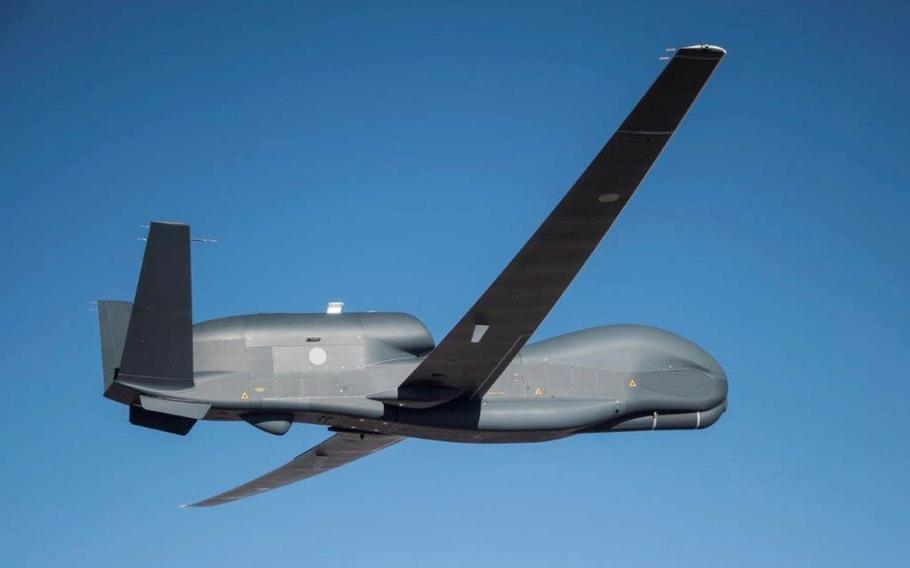
An RQ-4B Global Hawk aircraft that lifted off for the first time Thursday, April 15, 2021, from Palmdale, Calif., is the first of three that will be operated by the Japan Air Self-Defense Force. (Northrop Grumman)
An RQ-4B Global Hawk that lifted off last week for the first time from Palmdale, Calif., is the first of three that will be operated by the Japan Air Self-Defense Force, according to manufacturer Northrop Grumman.
The drones will be deployed to Misawa Air Base, in the country’s northeast, sometime this year or later, a spokeswoman for Japan’s Defense Ministry said Monday. Ministry officials typically provide comments on condition of anonymity.
The Global Hawk flies at 60,000 feet and has a line of sight to targets more than 340 miles away, according to Northrop Grumman. The exact range of the aircraft’s cameras and sensors is classified, but a Global Hawk flying near the Korean Demilitarized Zone, for example, could see well beyond the Yalu River that marks North Korea’s border with China.
Northrop Grumman did not provide details about the Japan-bound drone’s maiden flight but said in a statement Friday that it was successful.
“The unarmed RQ-4B Global Hawk will provide Japan with on-demand intelligence, surveillance and reconnaissance information supporting the Japan Air Self-Defense Force’s missions of protecting borders, monitoring threats and providing humanitarian assistance in times of need,” Jane Bishop, an autonomous systems manager at Northrop Grumman, said in the statement. “This successful first flight is a significant milestone in delivering Global Hawk to our Japanese allies.”
The U.S. Air Force has positioned its own Global Hawks at Misawa for several summers since 2014. The aircraft come to Japan to avoid typhoons at Andersen Air Force Base, Guam. In recent years, including 2020, the drones have operated out of Yokota Air Base, in western Tokyo, during summer.
“Once fielded, Global Hawk will integrate with other Japanese intelligence assets, including ground-based command and control units,” Northrop Grumman said in its statement.
When Japan’s RQ-4B fleet is fully operational, it will join allied nations operating the high-altitude drones that include Australia, South Korea and members of the North Atlantic Treaty Organization, the statement said.
The Japanese drones could monitor the Senkaku Islands with “considerably more time on station than manned systems,” Ralph Cossa, president emeritus of the Pacific Forum think tank in Hawaii, said in an email Monday.
The remote, Japanese administered islands are also claimed by Taiwan and China and there have been regular maritime face-offs in the waters surrounding them.
It is possible that Japan will also use the drones to monitor Russia, according to Paul Buchanan, an American security analyst based in Auckland, New Zealand.
Japan and Russia have a territorial dispute over four northern islands — Etorofu, Kunashiri, Shikotan and the Habomai — that were occupied by Russia at the end of World War II.
Japan’s 2015 decision to spend $500 million on the drones, which perform similar functions to high altitude spy planes such as the U.S. U-2 and SR-71, was questioned by some last year due to rising costs, Buchanan said in an email Monday.
The downing of a U.S. RQ-4 by Iran in 2019 showed that even at high altitude the planes may be vulnerable to surface-launched missiles operated by potential adversaries such as China and North Korea, he said.
“As a maritime nation one would think that Japan has more use for the maritime variant (MQ-4C Triton),” Buchanan said, noting that Australia is due to receive the Triton in 2023. “But it seems that now that the first of the Japanese RQ-4Bs is ready for delivery, the purchase agreement will be completed.”
Deployment of the drones will allow early detection, monitoring and tracking of mobile missiles from China and North Korea, Buchanan said.
“Done in coordination with … strike aircraft, this potentially offers a layer of security in the event of surprise tactical missile or airborne attacks emanating from [China] and [North Korea], to say nothing of any massing of land-based military assets in either country,” he said.
Stars and Stripes reporter Hana Kusumoto contributed to this report.
robson.seth@stripes.com Twitter: @SethRobson1